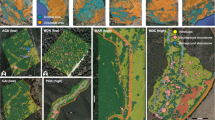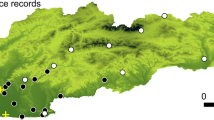Abstract
Aims
We determined effects of soil from three habitats differing in physiochemical properties on transgenerational plasticity in diaspore production of the diaspore-polymorphic annual Ceratocarpus arenarius.
Methods
Production of three disapore morphs and size of F0 plants in a sand desert (S) were evaluated. F1 plants from morphs at soil surface (a) and middle (c) and upper (f) parts of canopy of F0 plants were grown in soil from S, salt desert (SD) and desert steppe (DS) and evaluated for diaspore production and plant size.
Results
Number of dispersal unit morphs for F0 plants in S was (f > c)> > a. Plants from all three morphs varied in size, mass and mass allocation. For F1 plants (compared to F0), a:(c + f) was the same or increased in S (poor soil) and decreased in DS (good soil); c:(a + f) increased in S and DS; and f:(a + c) decreased in S and DS. In SD, ratios for F1 plants from a and c were the same as those in S, but ratios for F1 plants from f were the same as those in S and DS.
Conclusions
Differences in soil physiochemistry caused flexibility in plant size, mass and mass allocation and proportion of diaspore morphs across generations.




Similar content being viewed by others
References
Barker NP (2005) A review and survey of basicarpy, geocarpy, and amphicarpy in the African and Madagascan flora. Ann Missouri Bot Gard 92:445–462
Baskin CC, Baskin JM (2014) Seeds: ecology, biogeography, and evolution of dormancy and germination, second ed. Elsevier/Academic Press, San Diego
Baskin JM, Lu JJ, Baskin CC, Tan DY, Wang L (2014) Diaspore dispersal ability and degree of dormancy in heteromorphic species of cold deserts of Northwest China: a review. Perspect Plant Ecol Evol Syst 16:93–99
Bhattacharya S, Sperber K, Özüdoğru B, Leubner-Metzger G, Klaus M (2019) Naturally-primed life strategy plasticity of dimorphic Aethionema arabicum facilitates optimal habitat colonization. Sci Rep 9:16108. https://doi.org/10.1038/s41598-019-52520-y
Brändel M (2007) Ecology of achene dimorphism in Leontodon saxatilis. Ann Bot 100:1189–1197
Burke A (1995) Geigeria alata in the Namib desert: seed heteromorphism in an extremely arid environment. J Veg Sci 6:473–478
Cheplick GP (1992) Sibling competition in plants. J Ecol 80:567–575
Cheplick GP, Quinn JA (1982) Amphicarpum purshii and the “pessimistic strategy” in amphicarpic annuals with subterranean fruit. Oecologia 52:327–332
Clauss MJ, Venable DL (2000) Seed germination in desert annuals: an empirical test of adaptive bet hedging. Am Nat 155:168–186
Gan L, Lu JJ, Liu B, Baskin CC, Baskin JM, Tan DY (2020) Phenotypic plasticity in diaspore production of a amphi-basicarpic cold desert annual that produces polymorphic diaspores. Sci Rep 10:11142. https://doi.org/10.1038/s41598-020-67380-0
Gardocki ME, Zablocki H, El-Keblawy A, Freeman DC (2000) Heterocarpy in Calendula micrantha (Asteraceae): the effects of competition and availability of water on the performance of offspring from different fruit morphs. Evol Ecol Res 2:701–718
Hughes PW (2018) Minimal-risk seed heteromorphism: proportions of seed morphs for optimal risk-averse heteromorphic strategies. Front Plant Sci 9:1412. https://doi.org/10.3389/fpls.2018.01412
Imbert E (2002) Ecological consequences and ontogeny of seed heteromorphism. Perspect Plant Ecol Evol Syst 5:13–36
Levin SA, Cohen D, Hastings A (1984) Dispersal strategies in patchy environments. Theor Popul Biol 26:165–191
Lu JJ, Tan DY, Baskin JM, Baskin CC (2013) Tradeoffs between seed dispersal and dormancy in an amphi-basicarpic cold desert annual. Ann Bot 112:1815–1827
Lu JJ, Tan DY, Baskin JM, Baskin CC (2014) Two kinds of persistent soil seed banks in an amphi-basicarpic cold desert annual. Seed Sci Res 24:293–300
Lu RK (2000) Soil agrochemical analysis. China Agricultural Science and Technology Press, Beijing (in Chinese)
Lv YZ, Li BG (2010) Soil Science Experiments. China Agricultural Publishing House, Beijing (in Chinese)
Mandák B (1997) Seed hetermorphism and the life cycle of plants: a literature review. Preslia 69:129–159
Mandák B, Pyšek P (1999a) Effects of plant density and nutrient levels on fruit polymorphism in Atriplex sagittata. Oecologia 119:63–72
Mandák B, Pyšek P (1999b) How does density and nutrient stress affect allometry and fruit production in the heterocarpic species Atriplex sagittata (Chenopodiaceae)? Can J Bot 77:1106–1119
Mandák B, Pyšek P (2005) How does seed heteromorphism influence the life history stages of Atriplex sagittata (Chenopodiaceae)? Flora 200:516–526
Mao ZM (1994) Flora of Xinjiang, vol 2(1). Science, Technology & Public Health Press, Urümqi, Xinjiang (in Chinese)
Philippi T (1993) Bet-hedging germination of desert annuals: beyond the first year. Am Nat 142:474–487
Qiao ZH (2008) Study on the influence factors of wilting point. J Water Resources Water Eng 19(2):82–84 (in Chinese with English abstract)
Shi YG, Sun ZB (2008) Climate characteristics of atmospheric precipitable water over Xinjiang and its variation. J Desert Res 28:519–525 (in Chinese with English abstract)
Soil physics laboratory, Institute of Soil Science, Chinese Academy of Sciences (1978) Measurement of physical properties of soil. Science Press, Beijing, pp 140–148 (in Chinese)
Su HC, Shen YP, Han P, Li J, Lan YC (2007) Precipitation and its impact on water resources and ecological environment in Xinjiang region. J Glaciol Geocryol 29:343–350 (in Chinese with English abstract)
Venable DL (1985) The evolutionary ecology of seed heteromorphism. Am Nat 126:577–595
Venable DL, Dyreson E, Morales E (1995) Population dynamic consequences and evolution of seed traits of Heterosperma pinnatum (Asteraceae). Am J Bot 82:410–420
Wang HF, Wei Y (2007) Seed polymorphism and fruit-set patterns of Salsola affinis. Biodivers Sci 15:419–424 (in Chinese with English abstract)
Wang L, Baskin JM, Baskin CC, Cornelissen JHC, Dong M, Huang ZY (2012) Seed dimorphism, nutrients and salinity differentially affect seed traits of the desert halophyte Suaeda aralocaspica via multiple maternal effects. BMC Plant Biol 12:170. https://doi.org/10.1186/1471-2229-12-170
Xinjiang General Exploration Team of Chinese Academy of Sciences (CAS), Institute of Botany of CAS (1978) Vegetation of Xinjiang and its utilization. Science Publishing House, Beijing (in Chinese)
Yang F, Baskin JM, Baskin CC, Yang X, Cao DC, Huang ZY (2017) Divergence in life history traits between two populations of a seed-dimorphic halophyte in response to soil salinity. Front Plant Sci 8:1028. https://doi.org/10.3389/fpls.2017.01028
Yao SX, Lan HY, Zhang FC (2010) Variation of seed heteromorphism in Chenopodium album and the effect of salinity stress on the descendants. Ann Bot 105:1015–1025
Zhang K, Baskin JM, Baskin CC, Cheplick G, Yang X, Huang Z (2020) Amphicarpic plants: definition, ecology, geographic distribution, systematics, life history, evolution and use in agriculture. Biol Rev 95:1442–1466
Acknowledgments
This research was supported in part by the Program for the National Natural Science Foundation of China (grant numbers U1803331, 31660122 and 32071668) and the Tianshan Innovative Research Team of Xinjiang Uygur Autonomous Region of China (grant number 2018D14010). We thank Associate Professor Hongqi Wu, Professor Hongtao Jia and Professor Jiandong Sheng for advice on procedures for determining soil physicochemical properties and the National Meteorological Information Center of China Meteorological Administration for providing the temperature data.
Author information
Authors and Affiliations
Contributions
J.L., L.G. and D.T. conceived and designed the experiments; J.L. and L.G. performed the experiments; J.L. analyzed the data; J.L., L.G., D.T., C.C.B. and J.M.B. wrote the manuscript. All authors reviewed and approved the manuscript.
Corresponding author
Additional information
Responsible Editor: Jeffrey Walck.
Publisher’s note
Springer Nature remains neutral with regard to jurisdictional claims in published maps and institutional affiliations.
Supplementary Information
ESM 1
(DOC 120 kb)
Rights and permissions
About this article
Cite this article
Lu, J., Gan, L., Tan, D. et al. Effects of the habitat-soil factor on transgenerational plasticity in a diaspore-polymorphic cold desert annual. Plant Soil 461, 355–367 (2021). https://doi.org/10.1007/s11104-020-04792-x
Received:
Accepted:
Published:
Issue Date:
DOI: https://doi.org/10.1007/s11104-020-04792-x




